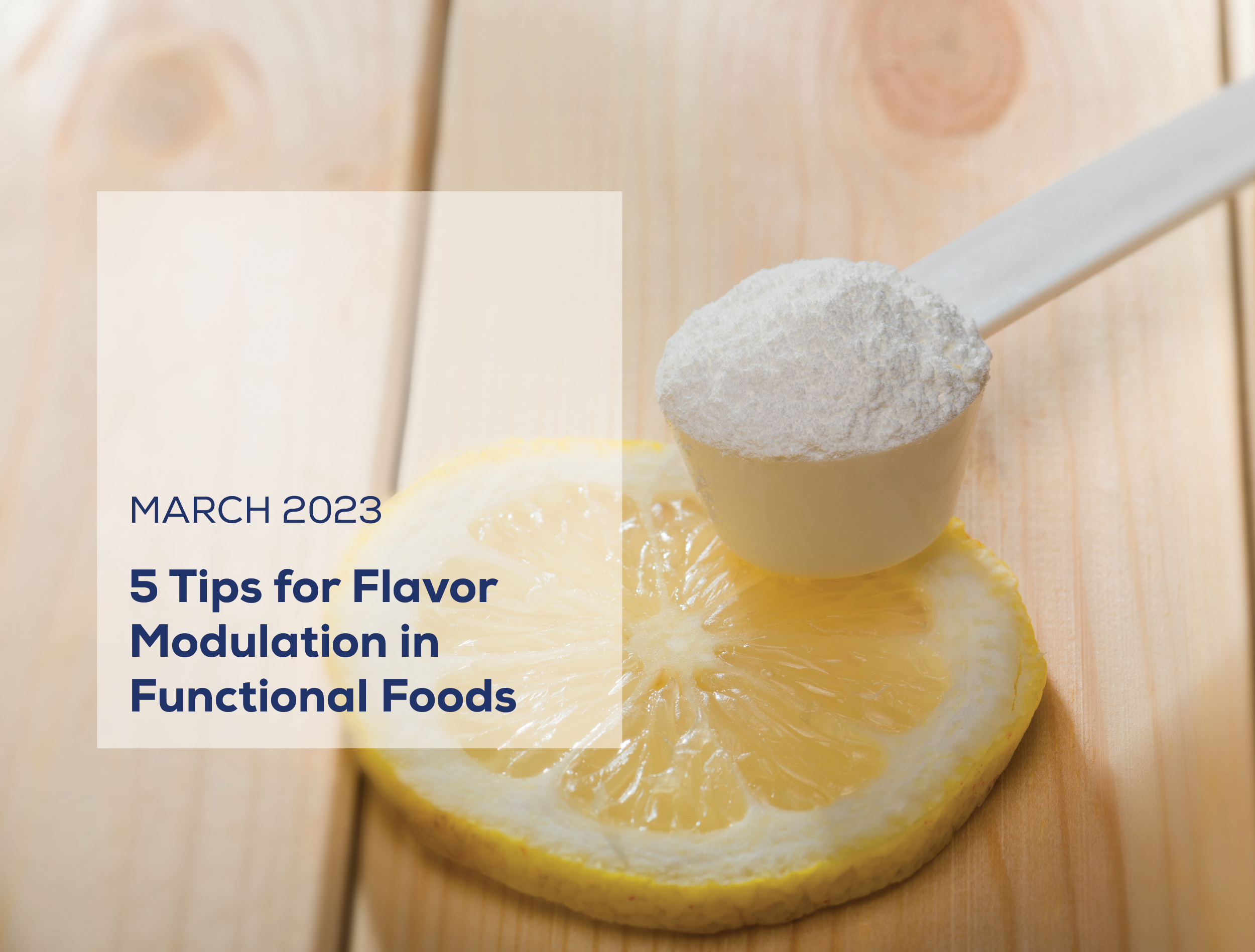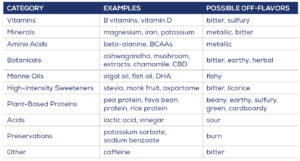
It’s no industry secret. Some functional ingredients with effects that customers crave simply don’t taste very good. Whether it be a bitter aftertaste or a sour front note, healthy and nutritious products sometimes have to be modulated, or changed, in order to be palatable to the masses. That being said, it’s not always as easy as mixing together great-tasting ingredients and serving up a delicious product to store shelves. Today’s customers want food and beverages that not only taste great but serve another function as well. From sugar reduction to vitamin fortification, shoppers simply expect more from their favorite brands.
That’s why flavor masking and flavor modulation are two of the most commonly used and desired food technology practices that exist today. And it’s why Custom Flavors has spent decades mastering them. If you’re ready to hear more about how to make your food and beverage products taste better without losing important functional ingredients, let’s discuss 5 Tips for Flavor Modulation in Functional Products.

1. Understand exactly what FMPs are and what they do before using them.
Flavors with modulating properties (FMPs) play an essential role in food by modifying or enhancing consumers’ sensory experiences. These flavors can improve the overall taste and aroma of food, mask or reduce off-flavors, or increase the perception of desirable flavors.
Here are the definitions and examples of three types of flavors with modulating properties:
Flavor Maskers: These are flavors that are used to cover up or reduce undesirable tastes or odors in food. As there is no single ingredient capable of hiding or masking every off-taste, the solution to masking undesirable flavor notes in food and beverage systems often relies on the right combination of different agents. Masking agents work in different ways depending on what ingredient they are masking and the food application. Most commercial masking agents are complex blends of flavor modifiers, inhibitors, and enhancers that cover an undesirable flavor characteristic by providing other sensations (taste modifying), competing with specific receptor sites (taste suppressing), or accentuating other flavors (taste enhancers).
Bitter Blockers: These are flavors that are used to block or reduce the perception of bitterness in food. Bitterness can be caused by a variety of compounds, including caffeine, quinine, and some plant extracts. Bitter blockers work by binding to the taste receptors that detect bitterness and preventing the compounds from activating those receptors. An example of a bitter blocker could be hops extract, which is used in beer to reduce the bitter taste.
Flavor Enhancers: These are flavors that are used to enhance or intensify desirable tastes and aromas in food. Flavor enhancers work by stimulating the taste receptors in the mouth and enhancing the perception of sweet, salty, sour, umami, or other flavors. For example, Stevia is a natural sweetener derived from the leaves of the stevia rebaudiana plant. It is several hundred times sweeter than sugar and is used as a sweetness enhancer in very small amounts or even as a sugar substitute in beverages, dairy products, and baked goods.

FMPs are a great way to add complexity and depth to your brand’s food and beverage products. These flavorings can be used to enhance a product’s natural flavors or add a twist to an existing formulation. They can also layer different flavors and create a unique flavor profile. By combining different flavors together, you can achieve a balance between sweet and savory, acidic and mild, and even a hint of bitterness and spice. With a wide variety of FMPs available directly from Custom Flavors, you can easily create a custom flavor profile that will tantalize the taste buds of your testers and target customers alike.
Easily keep up with any supplement trend with our superior flavor-masking library. Seamlessly work with our expert team to create a product that’s perfect for your customers’ tastebuds and tailor-made for their functional needs. If you’re interested in cooking up elevated fruity and decadent flavor profiles, we’ve got you covered. And one more thing…because you’re adding natural flavors to your formulation, you don’t even have to change the ingredients list when adding FMPs to mask specific off-notes!
2. Use traditional masking techniques during cooking and product development.
Although it can often feel very distant from our home kitchens at times, even large-scale food and beverage production is just making delicious and nutritious food for the people you and your team care about. When creating new flavors and tastes for your products, remember that the same wise advice that works when creating a great meal works for making a great food or beverage product:
- A touch of salt balances and enhances the impact of sweet or decadent flavors. Think delicious chocolate-covered pretzels or rich sea-salt caramel.
- Adding a bit of sugar or another sweet flavor to mask bitter or acrid flavors can hide unpleasant aftertastes of an important functional ingredient.
- Including an acid helps elevate and bring forward certain flavor notes by brightening and providing balance to both bitterness and sweetness.
This is just the tip of the flavor iceberg. When crafting new flavors or products, we recommend first relying on the basic principles of great flavors, food, and beverages that you already understand, and then adding on more complexity as you grow your product line. Feeling uncertain about the process? Contact our team here and let’s talk about flavor masking today.
3. Remember which ingredients may require flavor masking in order to appeal to consumers.
Don’t settle for trial and error. Leverage our decades of experience and time spent creating custom, delicious flavor formulations for food and beverage companies of all sizes in order to quickly identify which of your ingredients may be causing off-tastes. Here are some common functional ingredients that are often the culprit for undesirable flavors:
4. Follow the proper steps to mask an off-flavor in a flavor system.
- Optimizing the base
- Adjust the recipe based on the 5 basic tastes to achieve a balanced profile. Using different types or grades of ingredients, and incorporating fats or gums for example, may help improve the texture and mouthfeel of a product by providing a creamy or rich taste.
- Choose the right flavor
- When picking the custom flavor profile to reduce or eliminate off-flavors, manufacturers should consider the specific functional ingredient and its current flavor profile, as well as the desired taste and sensory experience of the finished product.
- When picking the custom flavor profile to reduce or eliminate off-flavors, manufacturers should consider the specific functional ingredient and its current flavor profile, as well as the desired taste and sensory experience of the finished product.
- Using a masking solution
- Don’t get discouraged, get professional guidance and flavor expertise. If off-notes are coming from multiple ingredients, work with a reputable flavor house like Custom Flavors to design a single solution around your unique base to address all the issues within a product. There are natural flavors that will help you hide those off-notes AND optimize your overall product taste, you just need to identify them.

5. Reach out for expert help with flavor masking—your customers (and their tastebuds) will thank you!
Check out these examples of some of our top flavors used in masking off-notes in functional products:
Refreshing Profiles
- Mixed Berry
- Limoncello
- Key Lime
- Pineapple + Passionfruit
- Mango Orange
Decadent Profiles
- Salted Caramel
- Chocolate Fudge Brownie
- Vanilla Marshmallow
- Banana Nut
- Strawberry Milkshake
Regardless of effort or resources, when it comes to flavor masking and functional products sometimes it just takes the right bit of knowledge to get the perfect flavor profile. Don’t spend time on combinations that end up displaying undesirable or distracting flavors, give our expert team of flavorists a chance to help you find that perfect balance of flavors. Schedule a call with us today and let’s get cooking!


